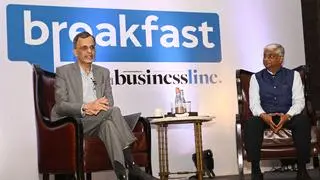With festival demand waning, the manufacturing sector slowed down in December, with the HSBC India Purchasing Managers’ Index (PMI) dropping to an 18-month low of 54.9 as against 56 in November. However, the sector is still in expansion mode.

“India’s manufacturing sector continued to expand in December, although at a softer pace, following an uptick in the previous month. While growth of both output and new orders softened, the future output index has risen since November. The rates of increase in input and output prices were broadly unchanged,” said Pranjul Bhandari, Chief India Economist at HSBC.
The index is compiled by S&P Global from responses to questionnaires sent to purchasing managers in a panel of around 400 manufacturers. The panel is stratified by detailed sector and company workforce size, based on contributions to GDP. The index gives an indication of the performance of the manufacturing sector in advance, before release of official data.
Manufacturing has a 15 per cent share in Gross Value Added (GVA) and is considered the biggest source of employment.
The report accompanying PMI said though the sector lost momentum in December, it is still expanding strongly. “There were softer, albeit sharp, increases in factory orders and output, while business confidence towards the year-ahead outlook strengthened,” it said. Further, input costs rose at the second-slowest rate in nearly three-and-a-half years, and charge inflation softened to a nine-month low.
Data collected through the survey showed a general lack of pressure on the capacity of manufacturers at the end of the third fiscal quarter. This was evidenced by a marginal uptick in outstanding business volumes. Subsequently, “employment was largely stable in December, with the respective seasonally adjusted index registering only fractionally above the 50.0 no-change mark,” the report said.
With regard to stocks, the latest results showed a further increase in input holdings alongside another decline in inventories of finished products. The latter was attributed to the fulfilment of orders from warehoused items. The key determinant of rising input inventories was a sustained increase in buying levels. Quantities of purchases expanded throughout the latest two-and-a-half years.
“The pace of growth seen in December was sharp, albeit the slowest since November 2022. When assessing the year-ahead outlook for production, Indian manufacturers were at their most upbeat in three months. Anecdotal evidence highlighted advertising, better customer relations, and new enquiries as the main factors boosting business confidence in December,” the report concluded.








Comments
Comments have to be in English, and in full sentences. They cannot be abusive or personal. Please abide by our community guidelines for posting your comments.
We have migrated to a new commenting platform. If you are already a registered user of TheHindu Businessline and logged in, you may continue to engage with our articles. If you do not have an account please register and login to post comments. Users can access their older comments by logging into their accounts on Vuukle.